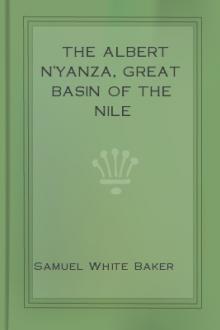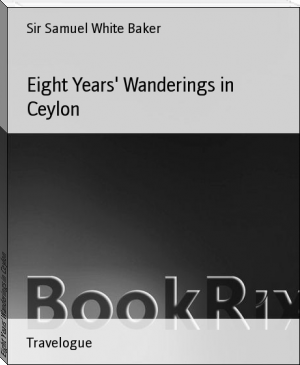The Albert N'Yanza, Great Basin of the Nile, Samuel White Baker [inspirational novels .TXT] 📗

- Author: Samuel White Baker
- Performer: -
Book online «The Albert N'Yanza, Great Basin of the Nile, Samuel White Baker [inspirational novels .TXT] 📗». Author Samuel White Baker
converted them into a stew, and then took refuge, wet and miserable,
under our untanned oxhides until the following morning. Although an
ox-hide is not waterproof, it will keep out a considerable amount of
wet; but when thoroughly saturated, it is about as comfortable as any
other wet leather, with the additional charm of an exceedingly
disagreeable raw smell, very attractive to hyenas. The night being dark,
several men thus lost their leather bags that they had left upon the
rock.
At 6 A.M., having passed a most uncomfortable night, we started, and
after a march of about two miles I was made extremely anxious for the
donkeys, by being assured that it was necessary to ascend a most
precipitous granite hill, at least seven hundred feet high, that rose
exactly before us, and upon the very summit of which was perched a large
village. There was no help by means of porters; we led our horses with
difficulty up the steep face of the rock—fortunately they had never
been shod, thus their firm hoofs obtained a hold where an iron shoe
would have slipped; and after extreme difficulty and a most tedious
struggle, we found our party all assembled on the flat summit. From this
elevated point we had a superb view of the surrounding country, and I
took the compass bearing of the Latooka mountain Gebel Lafeet, N. 45
degrees east. The natives of the village that we had now reached had
nothing to sell but a few beans, therefore without further delay we
commenced the descent upon the opposite side, and at 2.40 P.M. we
reached the base, the horses and donkeys having scrambled over the large
blocks of stone with the greatest labour. At the foot of the hill the
country was parklike and well wooded, although there was no very large
timber. Here the grass was two feet high and growing rapidly, while at
Latooka all was barren. Halted at 5.20 P.M. on the banks of a small
running stream, a tributary to the Kanieti. The night being fine we
slept well; and the next morning at 6 A.M. we commenced the most lovely
march that I have ever made in Africa. Winding through the very bosom of
the mountains, well covered with forest until the bare granite peaks
towered above all vegetation to the height of about 5,000 feet, we
continued through narrow valleys bordered by abrupt spurs of the
mountains from 1,700 to 2,000 feet high. On the peak of each was a
village; evidently these impregnable positions were chosen for security.
At length the great ascent was to be made, and for two hours we toiled
up a steep zigzag pass. The air was most invigorating; beautiful wild
flowers, some of which were highly scented, ornamented the route, and
innumerable wild grape-vines hung in festoons from tree to tree. We were
now in an elevated country on the range of mountains dividing the lower
lands of Latooka from the high lands of Obbo. We arrived at the summit
of the pass about 2,500 feet above the Latooka valley. In addition to
the wild flowers were numerous fruits, all good; especially a variety of
custard apple, and a full-flavoured yellow plum. The grapes were in most
promising bunches, but unripe. The scenery was very fine; to the east
and southeast, masses of high mountains, while to the west and south
were vast tracts of parklike country of intense green. In this elevated
region the season was much farther advanced than in Latooka;-this was
the mountain range upon which I had formerly observed that the storms
had concentrated; here the rainy season had been in full play for
months, while in Latooka everything was parched. The grass on the west
side of the pass was full six feet high. Although the ascent had
occupied about two hours, the descent on the west side was a mere
trifle, and was effected in about fifteen minutes—we were on an
elevated plateau that formed the watershed between the east and west.
After a march of about twelve miles from the top of the pass, we arrived
at the chief village of Obbo. The rain fell in torrents, and, soaked to
the skin, we crawled into a dirty hut. This village was forty miles S.W.
of Tarrangolle, my headquarters in Latooka.
The natives of Obbo are entirely different to the Latookas, both in
language and appearance. They are not quite naked, except when going to
war, on which occasion they are painted in stripes of red and yellow;
but their usual covering is the skin of an antelope or goat, slung like
a mantle across the shoulders. Their faces are well formed, with
peculiarly fine-shaped noses. The headdress of the Obbo is remarkably
neat, the woolly hair being matted and worked with thread into a flat
form like a beaver’s tail, and bound with a fine edge of raw hide to
keep it in shape. This, like the headdress of Latooka, requires many
years to complete.
From Obbo to the Southeast all is mountainous, the highest points of the
chain rising to an elevation of four or five thousand feet above the
general level of the country; to the south, although there are no actual
mountains, but merely a few isolated hills, the country distinctly
rises.
The entire drainage is to the west and northwest, in which direction
there is a very perceptible inclination. The vegetation of Obbo, and the
whole of the west side of the mountain range, is different from that
upon the east side; the soil is exceedingly rich, producing an abundance
of Guinea grass, with which the plains are covered. This country
produces nine varieties of yams, many of which grow wild in the forests.
There is one most peculiar species, called by the natives “Collolollo,”
that I had not met with in other countries. This variety produces
several tubers at the root, and also upon the stalk; it does not spread
upon the ground, like most of the vines that characterise the yams, but
it climbs upon trees or upon any object that may tempt its tendrils.
From every bud upon the stalk of this vine springs a bulb, somewhat
kidney-shaped; this increases until, when ripe, it attains the average
size of a potato.
So prolific is this plant, that one vine will produce about 150 yams:
they are covered with a fine skin of a greenish brown, and are in
flavour nearly equal to a potato, but rather waxy.
There are many good wild fruits, including one very similar to a walnut
in its green shell; the flesh of this has a remarkably fine flavour, and
the nut within exactly resembles a horse-chestnut in size and fine
mahogany colour. This nut is roasted, and, when ground and boiled, a
species of fat or butter is skimmed from the surface of the water: this
is much prized by the natives, and is used for rubbing their bodies,
being considered as the best of all fats for the skin; it is also eaten.
Among the best of the wild fruits is one resembling raisins; this grows
in clusters upon a large tree. Also a bright yellow fruit, as large as a
Muscat grape, and several varieties of plums. None of these are produced
in Latooka. Ground-nuts are also in abundance in the forests; these are
not like the well-known African ground-nut of the west coast, but are
contained in an excessively hard shell. A fine quality of flax grows
wild, but the twine generally used by the natives is made from the fibre
of a species of aloe. Tobacco grows to an extraordinary size, and is
prepared similarly to that of the Ellyria tribe.
When ripe, the leaves are pounded in a mortar and reduced to a pulp; the
mass is then placed in a conical mould of wood, and pressed. It remains
in this until dry, when it presents the shape of a loaf of sugar, and is
perfectly hard. The tobacco of the Ellyria tribe is shaped into cheeses,
and frequently adulterated with cowdung. I had never smoked until my
arrival in Obbo, but having suffered much from fever, and the country
being excessively damp, I commenced with Obbo pipes and tobacco.
Every tribe has a distinct pattern of pipe; those of the Bari have wide
trumpet-shaped mouths; the Latooka are long and narrow; and the Obbo
smaller and the neatest. All their pottery is badly burned, and
excessively fragile if wet. The water jars are well formed, although the
potter’s wheel is quite unknown, and the circular form is obtained
entirely by the hand. Throughout the tribes of the White Nile, the
articles of pottery are limited to the tobacco-pipe and the water-jar:
all other utensils are formed either of wood, or of gourd shells.
By observation, 1 determined the latitude of my camp at Obbo to be 4
degrees 02’ N., 32 degrees 31’ long. E., and the general elevation of
the country 3,674 feet above the sea, the temperature about 76 degrees
F. The altitude of Latooka was 2,236 feet above the sea level: thus we
were, at Obbo, upon an elevated plateau, 1,438 feet above the general
level of the country on the east of the mountain range. The climate
would be healthy were the country sufficiently populated to war
successfully against nature; but the rainfall continuing during ten
months of the year, from February to the end of November, and the soil
being extremely fertile, the increase of vegetation is too rapid, and
the scanty population are hemmed in and overpowered by superabundant
herbage. This mass of foliage, and grasses of ten feet in height
interwoven with creeping plants and wild grape-vines, is perfectly
impenetrable to man, and forms a vast jungle, inhabited by elephants,
rhinoceros, and buffaloes, whose ponderous strength alone can overcome
it. There are few antelopes, as those animals dislike the grass jungles,
in which they have no protection against the lion or the leopard, as
such beasts of prey can approach them unseen. In the month of January
the grass is sufficiently dry to burn, but even at that period there is
a quantity of fresh green grass growing between the withered stems; thus
the firing of the prairies does not absolutely clear the country, but
merely consumes the dry matter, and leaves a ruin of charred herbage,
rendered so tough by the burning, that it is quite impossible to ride
without cutting the skin from the horse’s shins and shoulders.
Altogether, it is a most uninteresting country, as there is no
possibility of traversing it except by the narrow footpaths made by the
natives.
The chief of Obbo came to meet us with several of his head men. He was
an extraordinary-looking man, about fifty-eight or sixty years of age;
but, far from possessing the dignity usually belonging to a grey head,
he acted the buffoon for our amusement, and might have been a clown in a
pantomime.
The heavy storm having cleared, the nogaras beat, and our entertaining
friend determined upon a grand dance; pipes and flutes were soon heard
gathering from all quarters, horns brayed, and numbers of men and women
began to collect in crowds, while old Katchiba, the chief, in a state of
great excitement, gave orders for the entertainment.
About a hundred men formed a circle; each man held in his left hand a
small cup-shaped drum, formed of hollowed wood, one end only being
perforated, and this was covered with the skin of the elephant’s ear,
tightly stretched. In the centre of the circle was the chief dancer, who
wore, suspended from his shoulders, an immense drum, also covered with
the elephant’s ear. The dance commenced by all singing remarkably well a
wild but agreeable tune in chorus, the big drum directing the time, and
the whole of the little





Comments (0)